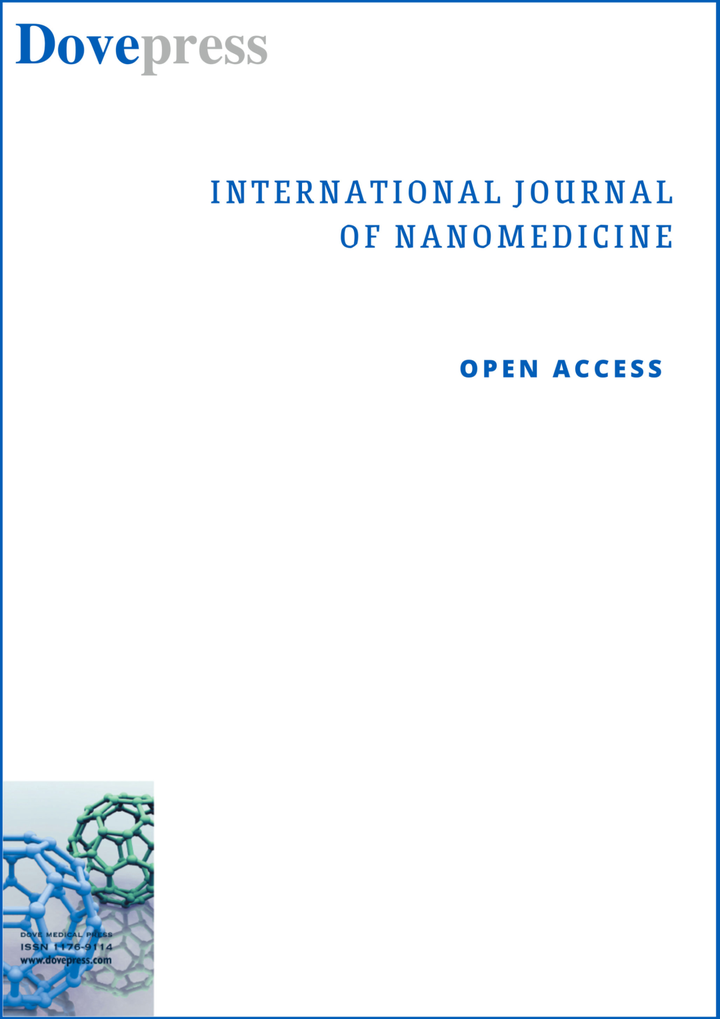Photodynamic Therapy Using RGD-Functionalized Quantum Dots Elicit a Potent Immune Response in a Syngeneic Mouse Model of Pancreatic Cancer
IF 6.6
2区 医学
Q1 NANOSCIENCE & NANOTECHNOLOGY
引用次数: 0
Abstract
Purpose: Photodynamic therapy (PDT) induces anti-tumor immune responses by triggering immunogenic cell death in tumor cells. Previously, we demonstrated that novel QDs-RGD nanoparticles exhibited high efficiency as photosensitizers in the treatment of pancreatic cancer. However, the underlying mechanism of the anti-tumor immune effects induced by the photosensitizer remains unknown. This study assessed the anticancer immune effect of QDs-RGD, as well as the conventional photosensitizer chlorine derivative, YLG-1, for comparison, against pancreatic cancer in support of superior therapeutic efficacy.Methods: The pancreatic cancer cell line, Panc02, was used for in vitro studies. C57BL/6 mice bearing pancreatic cancer cell-derived xenografts were generated for in vivo studies to assess the anti-tumor effects of QDs-RGD-PDT and YLG-1-PDT. The immunostimulatory ability of both photosensitizers was examined by measuring the expression of damage-associated molecular patterns (DAMP), such as calreticulin (CRT), assessing dendritic cell (DC) maturation, and analyzing cytokine expression. The specific immunity of QDs-RGD and YLG-1-PDT on distant tumor were determined by combining PDT with anti-CTLA-4 antibody.
Results: QDs-RGD-PDT and YLG-1-PDT significantly inhibited pancreatic cancer cell growth in a dose- and time-dependent manner. While both photosensitizers significantly promoted CRT release, DC maturation, and interferon γ (IFN-γ) and tumor necrosis factor α (TNF-α) expression, QDs-RGD exerted a stronger immunostimulatory effect than YLG-1. Combination treatment with QDs-RGD and CTLA-4 blockade was able to significantly inhibit the growth of distant tumors.
Conclusion: QDs-RGD is a novel and effective PDT strategy for treating pancreatic tumors by inducing anti-tumor immune responses.
Keywords: quantum dots, RGD peptides, cancer immunotherapy, pancreatic neoplasm
使用 RGD 功能化量子点的光动力疗法可在胰腺癌共生小鼠模型中引发强效免疫反应
目的:光动力疗法(PDT)通过引发肿瘤细胞的免疫性细胞死亡来诱导抗肿瘤免疫反应。此前,我们证明了新型 QDs-RGD 纳米粒子作为光敏剂治疗胰腺癌具有很高的效率。然而,光敏剂诱导抗肿瘤免疫效应的内在机制仍然未知。本研究评估了 QDs-RGD 以及传统光敏剂氯衍生物 YLG-1 对胰腺癌的抗癌免疫效应,以支持其卓越的疗效:方法:使用胰腺癌细胞系 Panc02 进行体外研究。方法:使用胰腺癌细胞系 Panc02 进行体外研究,并生成携带胰腺癌细胞衍生异种移植的 C57BL/6 小鼠进行体内研究,以评估 QDs-RGD-PDT 和 YLG-1-PDT 的抗肿瘤效果。通过测量损伤相关分子模式(DAMP)(如钙网蛋白(CRT))的表达、评估树突状细胞(DC)的成熟度以及分析细胞因子的表达,研究了这两种光敏剂的免疫刺激能力。通过将PDT与抗CTLA-4抗体结合,确定了QDs-RGD和YLG-1-PDT对远处肿瘤的特异性免疫:结果:QDs-RGD-PDT和YLG-1-PDT以剂量和时间依赖的方式显著抑制了胰腺癌细胞的生长。虽然两种光敏剂都能明显促进CRT释放、DC成熟、干扰素γ(IFN-γ)和肿瘤坏死因子α(TNF-α)表达,但QDs-RGD比YLG-1具有更强的免疫刺激作用。QDs-RGD与CTLA-4阻断联合治疗能够显著抑制远处肿瘤的生长:QDs-RGD是通过诱导抗肿瘤免疫反应治疗胰腺肿瘤的一种新型有效的PDT策略。 关键词:量子点;RGD肽;肿瘤免疫治疗;胰腺肿瘤
本文章由计算机程序翻译,如有差异,请以英文原文为准。
求助全文
约1分钟内获得全文
求助全文
来源期刊

International Journal of Nanomedicine
NANOSCIENCE & NANOTECHNOLOGY-PHARMACOLOGY & PHARMACY
CiteScore
14.40
自引率
3.80%
发文量
511
审稿时长
1.4 months
期刊介绍:
The International Journal of Nanomedicine is a globally recognized journal that focuses on the applications of nanotechnology in the biomedical field. It is a peer-reviewed and open-access publication that covers diverse aspects of this rapidly evolving research area.
With its strong emphasis on the clinical potential of nanoparticles in disease diagnostics, prevention, and treatment, the journal aims to showcase cutting-edge research and development in the field.
Starting from now, the International Journal of Nanomedicine will not accept meta-analyses for publication.
 求助内容:
求助内容: 应助结果提醒方式:
应助结果提醒方式:


